State University of New York Upstate Medical University
 | |
Former name | Geneva Medical College (1834-1871) Syracuse University College of Medicine (1871–1950) |
|---|---|
Motto in English | Education, Research, Health Care, Service |
| Type | Public medical school |
| Established | 1834[1] |
Parent institution | State University of New York |
| Endowment | $110.7 million (2020)[2] |
| Budget | $1.8 billion (2020)[3] |
| Chancellor | Deborah F. Stanley, J.D.[4] |
| President | Mantosh Dewan, M.D.[5][6] |
Academic staff | 676 (2017)[7][8] |
| Students | 1,528 (Fall 2020)[9] |
| Undergraduates | 205 (Fall 2020)[9] |
| Postgraduates | 1,323 (Fall 2020)[10] |
| Location | Syracuse , New York , United States 43°02′34″N 76°08′24″W / 43.04278°N 76.14000°WCoordinates: 43°02′34″N 76°08′24″W / 43.04278°N 76.14000°W |
| Campus | Urban, 30 acres (0.12 km2)[8] |
| Colors | Navy Blue & Steel Blue |
| Website | upstate |
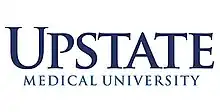 | |
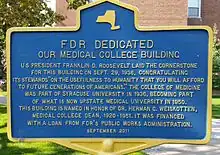
The State University of New York Upstate Medical University (SUNY Upstate) is a public medical school in Syracuse, New York. Founded in 1834, Upstate is the 15th oldest medical school in the United States and is the only medical school in Central New York. The school is an upper-division transfer and doctoral university with degree-granting programs in the Norton College of Medicine, College of Nursing, College of Health Professions, and the College of Graduate Studies. The university is part of the State University of New York (SUNY) system.
As one of only 140 academic medical centers in the United States,[11] the Upstate University Health System serves over 1.8 million people annually, often the most seriously ill and injured. Its facilities include Upstate University Hospital, the region's only Level 1 trauma and burn center;[12] Upstate Community Hospital; Golisano Children's Hospital; Upstate Brain & Spine Center; Upstate Heart and Vascular Center; Upstate Cancer Center; and other satellite sites in Central New York.[13]
Upstate provides 10,959 jobs,[14] making it Central New York's largest employer.[15] The university adds more than $2.5 billion to the state economy annually. Nearly 7,900 SUNY Upstate alumni physicians are licensed in the United States and they generate more than $24.8 billion in economic activity and support or employ nearly 132,354 employees.[16]
History
Geneva Medical College (1834-1871)
The present Upstate Medical University College of Medicine traces its ancestry to Geneva Medical College founded on September 15, 1834 as part of Geneva College, today known as Hobart and William Smith Colleges. The medical school, located in Geneva, New York, was the brainchild of Edward Cutbush, MD, who became its first dean. GMC held its first classes in February 1835, and became the first college to grant a full M.D. to a woman, Elizabeth Blackwell, in 1849.[1]
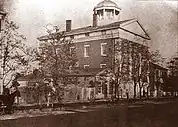
Among the early luminaries at GMC were Prof. of Surgery Frank Hastings Hamilton, pioneer in orthopedics, military surgery, and military hygiene; Stephen Smith, briefly a GMC student in 1847–1848, later an innovative sanitarian and surgeon in New York City; Lecturer in the Theory and Practice of Medicine Austin Flint, developer of modern methods of auscultation, cofounder (with Hamilton and several other GMC faculty) of the University of Buffalo College of Medicine, and eventually President of the American Medical Association (AMA); and Prof. of Anatomy and Physiology Willard Parker, who became the premier surgeon at Bellevue.[1]
.jpg.webp)
Syracuse University College of Medicine (1871-1950)
In 1871 Hobart disbanded GMC and sold its library, anatomical specimens, and other tangible assets to Dean John Towler. Acting as a private citizen, Towler donated these materials to the new Syracuse University on condition that the trustees immediately establish an AMA-approved medical school. Thus the Syracuse University College of Medicine came into being on December 4, 1871, with Frederick Hyde as dean.[1]
In the latter part of the century, the SU College of Medicine was among the first to institute a graded medical instruction program, with definite pre-clinical and clinical years and organize its curriculum according to the so-called "German model," with intense scientific and especially laboratory training for students in the first two years, and rigorous clinical training on rounds thereafter.[1] This tradition of steadily improving educational methods, practices, and facilities placed the SU College of Medicine in a good light for the Carnegie Foundation's Flexner Report in 1910. The Flexner Report hastened the demise of many medical schools in the United States and Canada, but, as Abraham Flexner wrote, "Of the eleven medical schools now existing in the state, only the bona-fide university departments can then expect to survive: outside of New York city, Syracuse University alone has just now a chance."[17]
Acquisition by The State University of New York (1950 - Present)
In 1950, State University of New York (SUNY) moved to add a medical center in Syracuse and ultimately acquired the College of Medicine from Syracuse University as a part of Governor Thomas E. Dewey's vision for Upstate New York.[17] After carrying the names "SUNY Upstate Medical Center" (initially) and "SUNY Health Science Center at Syracuse" (1986), the institution was renamed to become SUNY Upstate Medical University in 1999.

The first decade of the 21st century has been one of growth: the opening of the Institute for Human Performance for basic and clinical research; the East Tower expansion of University Hospital that houses the Golisano Children's Hospital and other clinical specialties; the Upstate cancer center; the Nappi Longevity Institute; a renovated gross anatomy lab; the Setnor Academic Building with a unique clinical skills center; and the purchase of land for a new Biotechnology Research Center; Geneva Tower including expansion of facilities past Interstate 81.[1] A plaque in the lobby of Weiskotten Hall, named for Herman Gates Weiskotten,[18] aptly describes one of the institution's driving philosophies: "Dedicated to all those of scientific mind and investigative spirit who purpose to serve humanity."
Campus
The university's main campus is located in the University Hill neighborhood of Syracuse, New York flanking Interstate 81. It includes Upstate University Hospital, the Institute for Human Performance, Setnor Academic Building, Central New York Gamma Knife Center, Jacobsen Hall, Regional Oncology Center, Upstate Golisano Children's Hospital, Weiskotten Hall, the Health Sciences Library, Silverman Hall and Geneva Tower residence hall. A clinical campus in Binghamton, New York was established in 1976. Medical students spend their first two years of medical school in Syracuse, New York and then approximately a quarter of the class completes their training in Binghamton. Although the Clinical Campus is community-based, Binghamton students spend similar amounts of time in hospitals on their rotations.[19]
Medical students on the Syracuse campus complete their clinical years at Upstate's own University Hospital and its affiliates. Students on the Syracuse campus learn alongside doctors using the most advanced technology and techniques:[20]
- At the Central New York Gamma Knife Center, neurosurgeons and radiologists treat patients with brain tumors once labeled inaccessible or inoperable.
 Upstate medical is located at the heart of downtown Syracuse, University Hill with neighboring Syracuse University and SUNY ESF.
Upstate medical is located at the heart of downtown Syracuse, University Hill with neighboring Syracuse University and SUNY ESF. - At Upstate's Clark Burn Center, experts provide state-of-the-art burn care, including hyperbaric oxygen therapy, for adult and pediatric patients from 25 counties.
- The Joslin Diabetes Center, one of only 13 prestigious Joslin sites in the country excels in diabetes management, education and treatment.
- The pediatric cardiac care specialists perform approximately 200 open-heart surgeries on children (some only hours old) each year.
Upstate University Health System
Upstate University Hospital is a 752-bed non-profit, teaching hospital located in Syracuse, New York.[21] Upstate University Hospital is a part of the Upstate Health System, as the flagship hospital in the system. As the hospital is a teaching hospital, it is affiliated with the Upstate Medical University.[22] The hospital is also an American College of Surgeons verified Level 1 Trauma Center, the only in the region and one of 21 in New York.[23] Attached to the hospital is the Upstate Golisano Children's Hospital that treats infants, children, teens, and young adults aged 0–21.[24]
In addition to being the region's only Level-I Trauma Center, Upstate includes:[25]

- Upstate Golisano Children's Hospital
- Upstate University Hospital Community Campus
- Upstate Cancer Center
- Upstate Brain & Spine Center
- Numann Center for Breast, Endocrine & Plastic Surgery
University Hospital's New York State Designated Centers include:
- Upstate Level I Adult Trauma Center
- Upstate Level I Pediatric Trauma Center, 1 of only 4 in New York
- Upstate Comprehensive Stroke Center
- Clark Burn Center
- Upstate Designated AIDS Center
There are seven clinical departments that offer surgery at Upstate University Hospital. Collectively, the hospital offers more surgeons, robotic instrumentation and specialty procedures than any other facility in Central New York, with the Department of Surgery providing the largest component. In addition, the past decade has seen the expansion of cancer surgical specialties at Upstate. The surgeons who treat cancer see patients through the Upstate Cancer Center, a newer facility which provides disease-specific, multidisciplinary care to patients with different types of cancer.[26]
The Upstate University Health System has been honored with numerous designations and awards for excellence in medicine, research and nursing by the National Institute of Health, New York State Department of Health, American College of Surgeons, American Heart Association, American Nurses Association, US News and World Report, Forbes, etc.[26][27][28][29]
In December 2020, Upstate announced that the American College of Surgeons National Surgical Quality Improvement Program (NSQIP) named Upstate Community Hospital as one of just 89 facilities nationwide for meritorious outcomes for surgical care. Among its many awards, Upstate also has earned DNV accreditation as a Center of Excellence for Hip and Knee and as Blue Distinction Center, which also was achieved by its spine program. The pancreatic surgery program is recognized by the National Pancreatitis Foundation as a National Center of Excellence, and the breast cancer program is accredited nationally. In 2018, NSQIP recognized Upstate University Hospital as a high performer regarding care of high-risk surgical patients.[26]
In 2019 and 2020 the hospital received "Stroke Gold Plus Award," "Heart Failure Gold Plus Quality Award," and the "Resuscitation Bronze Award" from the American Heart Association and the American Stroke Association.[27][28]
The hospital received "High Performing" in both heart failure and COPD on the 2020-21 U.S. News & World Report: Best Hospital rankings.[30]
Academics
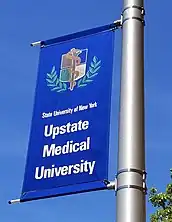
Upstate is an upper-division transfer and doctoral university classified as a Special Focus Four-Year: Medical Schools and Centers, 1 of only 54 in the nation, specializing solely in health care careers.[31] This means students applying to the bachelors programs take the prerequisite courses (minimum 60 semester hours) at another college and then complete their junior and senior years of the bachelor's degree at Upstate for their program of study. Students in the graduate and post-graduate programs enter having completed a bachelors and/or a master's degree prior to enrollment.[32]
In total, there are 1,592 students out of which 160 matriculate into the MD program, over 130 are admitted to the College of Health Professions and 400+ matriculate at the College of Nursing respectively.
Norton College of Medicine
The Norton College of Medicine is the 2nd and 15th oldest medical school in New York state and the United States respectively. More physicians practicing in Central New York received their training here than at any other medical school. The COM offers professional and graduate degrees including the Master of Public Health (MPH) and Doctor of Medicine (MD). In addition, in conjunction with the College of Graduate Studies, the COM grants joint degrees including the MD/PhD and MD/MPH.
The College of Medicine is the highest-funded school within the university, as a result graduates continue to do exceptionally well in obtaining high quality residencies and match into residencies at a higher rate than the national average.[33][34] Students in the College of Medicine have access to state of the art research facilities, classrooms, laboratories and clinical facilities, including the Clinical Skills Teaching Center, Surgical Simulation, Research and Training Center, Gross Anatomy lab etc.[35]
All College of Medicine students spend their first two years at the Upstate Medical University campus in Syracuse. At the start of the third year, one-fourth of the class moves to the Binghamton Clinical Campus, one hour south of Syracuse for their third year, and most elect to stay for their fourth. The rest of the class remains in Syracuse.[36]
As an academic medical center, most of the physicians and surgeons providing services at Upstate University Hospital also are faculty at Upstate's College of Medicine, demonstrating an ongoing commitment to education and training. Several departments — General Surgery, Ophthalmology, Urology, Orthopedics and Neurosurgery, in particular — have considerable faculty and external funding dedicated to their research mission. Surgeons also partner with external institutions, such as nearby Syracuse and Cornell Universities for tissue engineering and brain tumor research.[26]
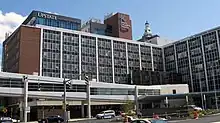
Along with the University Hospital, the College of Medicine has five clinical affiliates in Syracuse and over 400 clinical sites throughout Central New York, including:
- Syracuse Veteran Affairs Medical Center, over 650 of students, residents, interns, and fellows receive training at the Medical Center each year[37]
- Crouse Hospital, in operation since 1887 serves more than 22,000 discharges, over 82,000 emergency services visits and more than 365,000 outpatient visits each year[38]
- Upstate Community Hospital, boasts a medical staff of 460 physicians who provide premier out-patient and surgical services to more than 12,000 patients each year[39]
- St. Joseph's Hospital Health Center, is ranked among the top 15 heart surgery centers in the country and conducts over 9,000 surgeries and nearly 5,000 outpatient surgeries yearly[40]
In addition, there are more than 20 clinical departments at the college including Anesthesiology, Cardiology, Emergency Medicine, Family Medicine, Geriatrics, Internal Medicine, Neurology, Gastroenterology, Ophthalmology, Otolaryngology, Pathology, Pediatrics, Physical Medicine and Rehabilitation, Psychiatry, Public Health and Preventive Medicine, Radiation Oncology, Radiology etc. There are 619 residency spots at Upstate that are fully accredited by the Accreditation Council for Graduate Medical Education (ACGME).[41]
The College of Medicine's annual tuition for the MD program is: $43,670 (in-state) and $65,160 (out-of-state). The faculty-student ratio at Upstate Medical University is 0.9:1. The College of Medicine has 623 full-time faculty on staff.
In December 22, 2021, the College of Medicine was renamed the Alan and Marlene Norton College of Medicine in recognition of a $25 million estate gift made by Alan and Marlene Norton.[42][43] Alan Norton graduated from the College of Medicine in 1966 and then went on to complete his residency and fellowship training at the Wilmer Eye Institute of Johns Hopkins University and Massachusetts Eye and Ear.
College of Graduate Studies
The College of Graduate Studies awards the Ph.D. and M.S. in a variety of Biomedical Research Departments and is known for its basic science education and research. The graduate studies program began in 1947 when the college first offered master's and PhD degrees in biochemistry.[44] The college now has graduate programs for Biochemistry & Molecular Biology, Cell & Developmental Biology, Microbiology & Immunology, Neuroscience, Pharmacology and Physiology. In addition, the college along with the College of Medicine offers a joint MD/PhD.[45] The college also offers fellowships to budding undergraduate students through its Summer Undergraduate Research Fellowship (SURF) Program, along with research training opportunities through its Post-baccalaureate Research and Education Program (PREP-Up).[45]
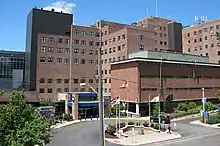
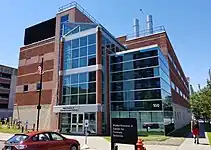
PhD students are given a full year before making the crucial decision as to the topic and mentor for their thesis research. During the first year, candidates rotate through three labs, choosing from a variety of well funded labs in leading-edge research areas. To help select rotations, faculty members from each department program take an afternoon early in the semester to present the research carried on in the program. After successful completion of lab rotations and a first-year core curriculum taught by faculty from throughout the college, students select their dissertation mentor and transition into the appropriate degree-granting program.[46]
Ph.D. students receive a competitive 12-month stipend of $27,121 and a full-tuition scholarship. By receiving stipends, Ph.D. students become part of the SUNY Graduate Student Employees Union, which provides periodic and automatic increases in stipend awards in addition to other benefits, including a low-cost health care package.[47]
College of Nursing
To meet the shortage of nurses, the State University of New York Upstate Medical University initiated an Associate degree program in 1959. More than 500 registered nurses were graduated from the program between 1959 and 1976. In 1974, as a response to the need for primary care nurses, a Nurse Practitioner Certificate Program was implemented. This program was supported primarily by federal grant monies. Over 300 Nurse Practitioners were graduated; many of them remained at Upstate Medical University upon graduation.[48]
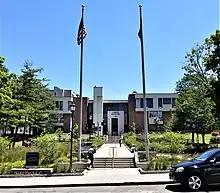
As enrollment grew, the College of Nursing was initially established in 1986, with Dr. M. Janice Nelson appointed as the first dean.[48] Soon after, it began offering bachelor's and master's degrees and currently has the following advanced education programs for RNs: Bachelor of Science, Master of Science (PNP, FNP and FPMHNP tracks), Post Masters Advanced Certificate (PNP, FNP, FPMHNP tracks) and Doctor of Nursing Practice (DNP).[49]
There are over 400+ students enrolled at the College of Nursing and the college boasts an impressive nearly 100 percent job placement rate after graduation for those seeking work.[49]
College of Health Professions
The College of Health Professions was formed in 1971. However, programs in the Health Professions have been in existence on this campus since 1956. Students can choose from nine health care fields: Behavior Analysis Studies (MS), Cardiovascular Perfusion (MS), Medical Biotechnology (BS and MS), Medical Imaging Sciences (BS), Physical Therapy (DPT), Physician Assistant (MS), Radiation Therapy (BS) and Respiratory Therapy (BS).
The College of Health Professions annually admits over 130 students into its programs. Retention rates average approximately 90 percent for the college. There are 32 full-time and 8 part-time faculty. In addition, there are more than 240 clinical and adjunct faculty who contribute to the college's educational programs.[50]
Research
As a biomedical research enterprise, Upstate focuses on the most prevalent human diseases, including cancer, diabetes, heart disease, nervous system disorders, vision, and infectious diseases. The quest for treatments and cures is built upon expertise in structural, molecular and systems biology. Grants are concentrated in five basic science departments; Upstate's clinical departments host more than 450 active clinical trials. Upstate's research expenditures of more than $35 million ripple through the state economy and generated an additional $20.7 million in indirect and induced activity.[14]
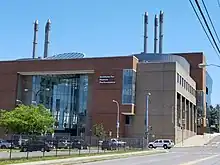
Upstate Medical University completed the construction of the Upstate Cancer Center, a five-story $74-million facility, in July 2014 and expanded it in 2018 to meet patient's demands and further research capability.[51][52] In addition, the Nappi Longevity Institute at Upstate Medical University—a five floor, nearly 200,000 square foot health and wellness complex—will be completed in 2023. To fund the $154 million project, Upstate received a $70.6 million grant as part of the Capital Restructuring Financing Program and Essential Health Care Provider Support Program, and an additional $70.6 million in matching bonds from New York state.[53] Upstate is currently designated as a Center of Excellence for Alzheimer's disease by New York State.[54]
Governor Andrew M. Cuomo congratulated Upstate Medical on its No.1 ranking COVID-19 saliva test by the U.S. Food and Drug Administration for detecting the virus in its earliest stages. The test developed by Upstate Medical and NY Start-Up Quadrant Biosciences, called Clarifi COVID-19, was also cited by the FDA as being among the most sensitive tests.[55]
On March 12, 2021, Upstate announced the grand opening of the Upstate Medical Vector Biocontainment Lab established to research infectious diseases that pose major public health risks. The new $7.6 million 2,500-square-foot laboratory was funded by New York State investment and will house clinical experts from State University of New York institutions who will collaborate on cutting-edge research of Coronavirus, Lyme, West Nile, Zika, Dengue, and other infectious diseases. The VBL also features a Human Challenge Room, where a human test subject may receive a mosquito bite, allowing for natural disease transmission and a potentially more accurate understanding of the disease and how to treat it.[56][57]
“You would find this only at the CDC or in an Army laboratory,” Thangamani, MD said of the Human Challenge Room. “It’s rare to find this in an academic setting."[57]
Cross-Functional Collaboration
In 2013, Upstate Medical University, in partnership with SUNY College of Environmental Science and Forestry (ESF), Syracuse University, Cornell University, the University of Rochester and SUNY Buffalo received a $2 million federal grant to acquire an 800 MHz Nuclear Magnetic Resonance (NMR) spectrometer. The acquisition of the spectrometer filled a void in the region's research landscape as this instrument will be the only one of its kind in Central and Western New York. "It speaks volumes about the power of a system when this grant was led by SUNY Upstate, the equipment will be housed at ESF, and its use will be open to scientists from across Central and Western New York," said SUNY Chancellor Nancy Zimpher.[58] In addition, Upstate and ESF were recently awarded $15 million through a competitive grant program to create the SUNY Institute of Environmental Health & Environmental Medicine.[59]
In addition, a joint Master of Public Health degree program and a joint PhD program in biomedical engineering are offered by SUNY Upstate and Syracuse University.[60] The campuses of the two universities are adjacent to each other on University Hill in Syracuse. In 2021, a research collaboration between Upstate Medical University and Syracuse University on detecting Alzheimer's disease won the IAAI-21 Deployed Application Award on Innovative Applications of Artificial Intelligence. In their paper the team states, "Our research is the first to develop an effective machine learning approach that can identify the latent patterns due to preclinical AD from MRI brain scans, which can significantly improve AD patients’ intervention and treatment.”[61]
Selectivity
Most recently, the MD program received over 7,000 applications for 160 seats, an increase of over 26% from the previous year to what some described as the "Fauci Effect".[62][63][64] In 2020, the incoming class had an average GPA of 3.77 and MCAT score of 513, which is 90th percentile nationally.[65][66] Over 52.6% of applicants were "Out of State" with respect to state residency and the remaining 47.4% were NYS residents.[62]
The College of Medicine has a 97% pass rate on the United States Medical Licensing Examination (USMLE) Step 1.[67] In addition, Upstate had a match rate of 97% vs. 92.8% nationally for US MD schools in 2021 for first-year residency positions.[68][69]U.S. News & World Report ranked the COM 31st in the Best Research category among all public medical schools nationally.[70]
In 2020, the PA program was ranked #46 nationally in the Best Physician Assistant Programs by U.S. News & World Report. The Physical Therapy program (DPT) was ranked #57 nationally in the Best Physical Therapy Programs by US News. In addition, the MPH program was ranked #104 nationally in the Best Public Health Schools category by US News.[71]
Notable alumni
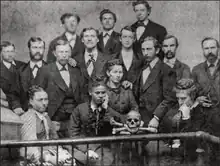
- Charles Antzelevitch, PhD - American cardiovascular research scientist in the fields of cardiac electrophysiology and arrhythmia syndromes.
- A. V. Apkarian, PhD - Professor of physiology, anesthesiology, and physical medicine and rehabilitation at Northwestern University in the Feinberg School of Medicine.
- Sir Frederick Ballantyne, M.D. - Governor-General of Saint Vincent and the Grenadines
- Elizabeth Blackwell, M.D. - first woman in the United States to be awarded the degree of Medical Doctor; founder of the New York Infirmary, now Lower Manhattan Hospital
- Penny Budoff, M.D. - famously known for her seminal research to alleviate menstrual pain
- George W. Cole, major general by brevet in the American Civil War.
- Mary Fowkes, MD/PhD - American physician and neuropathologist. She is noted for her early autopsies of COVID-19 victims that significantly contributed to the identification of long-term effects of the novel coronavirus
- Sarah Loguen Fraser, M.D. - in 1876, became the first woman to gain an M.D. from Syracuse University School of Medicine; believed to be the fourth African-American woman to become a licensed physician in the United States
- Marcus J. Goldman, M.D. - Associate Professor at Tufts University School of Medicine
- David B. Levine, M.D. - Director of the Department of Orthopedic Surgery at Hospital for Special Surgery
- Pamela Lipkin, M.D. - facial plastic surgeon specializing in nose work.
- Clemence Sophia Harned Lozier, M.D. - Founded the New York Medical College and Hospital for Women and served as president of the New York City Suffrage League and the National Women's Suffrage Association.
- Elizabeth R. McAnarney, M.D. - pediatrician who is recognized for her leadership in the fields of adolescent medicine and pediatrics
- Patricia Numann, M.D. - founder of the Association of Women Surgeons, former president of the American College of Surgeons, and professor emeritus at the Upstate Medical University.
- James B. Preston, M.D. - Professor emeritus and Chairman of the Department of Physiology, SUNY Upstate Medical University.
- Mark C. Rogers, M.D. - influential in the development of pediatric intensive care as an independent medical specialty in the United States.
- Thomas Szasz, M.D. - Professor Emeritus of Psychiatry
- Nancy J. Tarbell, M.D. - C.C. Wang Professor of Radiation Oncology at Harvard Medical School and Massachusetts General Hospital.
- Samuel O. Thier, M.D. - President of Brandeis University from 1991 to 1994, the President of the Massachusetts General Hospital from 1994 to 1996 and Professor of Medicine and Health Care Policy at Harvard University.
- Sid Watkins, M.D. - Professor of Neurosurgery, 1962–1970; later became head of the Formula One on-track medical team
- Herman Gates Weiskotten, served as dean of Syracuse University medical school from 1922 to 1951
- Michael Weitzman, M.D. - American pediatrician specializing in public health and policy known for his research focusing on the social and environmental determinants of child health.
- Thomas Bramwell Welch, M.D. - British–American minister and dentist
- Warren Winkelstein, MD/MPH - American epidemiologist, professor in the School of Public Health at the University of California, Berkeley, and a member of the Institute of Medicine of the U.S. National Academy of Sciences
- Frank E. Young, M.D. - Commissioner of Food and Drugs from 1984 to 1989 and later Deputy Assistant Secretary in the United States Department of Health and Human Services.
References
- 1 2 3 4 5 6 "History of the College of Medicine SUNY Upstate Medical University". www.upstate.edu. Archived from the original on June 19, 2019. Retrieved June 19, 2019.
- ↑ As of June 30, 2020. U.S. and Canadian Institutions Listed by Fiscal Year 2020 Endowment Market Value and Change in Endowment Market Value from FY19 to FY20 (Report). National Association of College and University Business Officers and TIAA. February 19, 2021. Retrieved February 20, 2021.
- ↑ As of July 31, 2020. Report of the President, Mantosh Dewan MD 2019-2020 (PDF) (Report). SUNY Upstate. 2020. Retrieved July 5, 2021.
- ↑ "https://www.localsyr.com/news/local-news/suny-names-former-oswego-state-president-as-interim-chancellor/". localsyr.com. December 20, 2021.
{{cite news}}: External link in|title= - ↑ Mulder, James T. (November 16, 2018). "Psychiatrist named interim president of SUNY Upstate". syracuse.com. Retrieved May 17, 2020.
- ↑ Holly, Liapis (November 4, 2020). "New Campus Leadership Announcements: SUNY Board of Trustees Appoints Presidents at Old Westbury, Upstate Medical, and SUNY ESF Campuses". SUNY Office of Communications (Press release). Retrieved November 4, 2020.
- ↑ "Upstate Medical University," Archived December 29, 2018, at the Wayback Machine College Navigator, National Center for Educational Statistics. Accessed: 29 December 2018.
- 1 2 "SUNY Upstate Facts at a Glance," Archived July 17, 2017, at the Wayback Machine Upstate website. Accessed: 26 June 2018.
- 1 2 . October 29, 2021 https://tableauserver.suny.edu/t/IRPublic/views/EnrollmentFastFacts2020/CampusEnrollment?:embed=y&:isGuestRedirectFromVizportal=y&:display_count=n&:showAppBanner=false&:origin=viz_share_link&:showVizHome=n.
{{cite web}}: Missing or empty|title=(help) SUNY website. Accessed: 29 October 2021. - ↑ "Upstate Medical University," Archived December 29, 2018, at the Wayback Machine National Center for Educational Statistics website. Accessed: December 29, 2018.
- ↑ "Clinical Connection".
{{cite web}}: CS1 maint: url-status (link) - ↑ "Upstate Golisano Children's Hospital".
{{cite web}}: CS1 maint: url-status (link) - ↑ "About Upstate".
{{cite web}}: CS1 maint: url-status (link) - 1 2 "The Economic and Community Impact of Upstate Medical University" (PDF).
{{cite web}}: CS1 maint: url-status (link) - ↑ "SUNY Upstate Grows As Budget Shrinks". 26 October 2010.
{{cite web}}: CS1 maint: url-status (link) - ↑ "The Economic and Community Impact of Upstate Medical University" (PDF).
{{cite web}}: CS1 maint: url-status (link) - 1 2 "College of Medicine Records A description of its records at the Syracuse University Archives". library.syr.edu. Retrieved March 29, 2020.
- ↑ Luft, Eric v d (2009). SUNY Upstate Medical University: A Pictorial History. Gegensatz Press. ISBN 9781933237350. Archived from the original on October 28, 2018. Retrieved October 28, 2018.
- ↑ "Binghamton Clinical Campus".
{{cite web}}: CS1 maint: url-status (link) - ↑ "Syracuse Clinical Campus".
{{cite web}}: CS1 maint: url-status (link) - ↑ "SUNY Upstate Facts at a Glance | About Upstate | SUNY Upstate Medical University". www.upstate.edu. Retrieved May 25, 2021.
- ↑ "Locations/Directions:SUNY Upstate Medical University". www.upstate.edu. Retrieved January 6, 2021.
- ↑ "Trauma Centers". American College of Surgeons. Archived from the original on 2021-01-06. Retrieved January 6, 2021.
- ↑ "Emergency Medicine | SUNY Upstate Medical University". www.upstate.edu. Archived from the original on January 6, 2021. Retrieved January 6, 2021.
- ↑ "About Upstate University Hospital".
{{cite web}}: CS1 maint: url-status (link) - 1 2 3 4 "Expansion in Surgery at Upstate University Hospital Makes It a Healthcare Destination".
{{cite web}}: CS1 maint: url-status (link) - 1 2 "Trio of awards highlights outstanding care in stroke, heart failure and resuscitation".
{{cite web}}: CS1 maint: url-status (link) - 1 2 "Upstate collects honors for outstanding care in stroke, heart failure and resuscitation".
{{cite web}}: CS1 maint: url-status (link) - ↑ "AMERICA'S BEST LARGE EMPLOYERS - 2021". Forbes.
{{cite web}}: CS1 maint: url-status (link) - ↑ "Upstate University Hospital".
{{cite web}}: CS1 maint: url-status (link) - ↑ "Special Focus Four Year Medical Schools".
{{cite web}}: CS1 maint: url-status (link) - ↑ "Applying to SUNY Upstate Medical University".
{{cite web}}: CS1 maint: url-status (link) - ↑ "MD Program".
{{cite web}}: CS1 maint: url-status (link) - ↑ "Upstate: Independent Auditor's Report" (PDF).
{{cite web}}: CS1 maint: url-status (link) - ↑ "Facilities: College of Medicine".
{{cite web}}: CS1 maint: url-status (link) - ↑ "Clinical Campus Options".
{{cite web}}: CS1 maint: url-status (link) - ↑ "About the Syracuse VA Medical Center".
{{cite web}}: CS1 maint: url-status (link) - ↑ "About Crouse".
{{cite web}}: CS1 maint: url-status (link) - ↑ "About Upstate Community Hospital".
{{cite web}}: CS1 maint: url-status (link) - ↑ "Who We Are: St. Joseph's Health".
{{cite web}}: CS1 maint: url-status (link) - ↑ "About Upstate Medical University".
{{cite web}}: CS1 maint: url-status (link) - ↑ "SUNY Upstate's medical school receives record $25 million gift". syracuse. 2021-12-22. Retrieved 2021-12-22.
- ↑ "Upstate Medical University announces naming gift for the College of Medicine | Upstate News | SUNY Upstate Medical University". www.upstate.edu. Retrieved 2021-12-22.
- ↑ "College of Graduate Studies: Our History".
{{cite web}}: CS1 maint: url-status (link) - 1 2 "College of Graduate Studies".
{{cite web}}: CS1 maint: url-status (link) - ↑ "About the College of Graduate Studies".
{{cite web}}: CS1 maint: url-status (link) - ↑ "Stipends, Tuition, Fees and Financial Aid".
{{cite web}}: CS1 maint: url-status (link) - 1 2 "History of the College of Nursing".
{{cite web}}: CS1 maint: url-status (link) - 1 2 "About the College of Nursing".
{{cite web}}: CS1 maint: url-status (link) - ↑ "About the College of Health Professions".
{{cite web}}: CS1 maint: url-status (link) - ↑ "Upstate to break ground on new cancer center next year".
{{cite web}}: CS1 maint: url-status (link) - ↑ "Four years after opening its doors, Upstate Cancer Center expands".
{{cite web}}: CS1 maint: url-status (link) - ↑ "Nappi Longevity Institute".
{{cite web}}: CS1 maint: url-status (link) - ↑ "The Nappis provide Upstate Foundation and Upstate Medical University with largest gift in history".
{{cite web}}: CS1 maint: url-status (link) - ↑ "Governor Cuomo Congratulates SUNY Upstate Medical on #1 FDA Ranking Among COVID-19 Saliva Tests for Detecting Virus In Earliest Stages".
{{cite web}}: CS1 maint: url-status (link) - ↑ "SUNY Announces Grand Opening of Vector Biocontainment Lab at Upstate Medical to Research Infectious Diseases".
{{cite web}}: CS1 maint: url-status (link) - 1 2 "Upstate opens new Vector Biocontainment Lab to propel research on coronavirus and other infectious diseases".
{{cite web}}: CS1 maint: url-status (link) - ↑ "$2M NIH Grant Brings Sophisticated Research Equipment to CNY".
{{cite web}}: CS1 maint: url-status (link) - ↑ "Upstate shares in special SUNY funding to create Institute for Environmental Health & Environmental Medicine".
{{cite web}}: CS1 maint: url-status (link) - ↑ "SUNY Upstate Medical University, Syracuse University Offer Joint Master of Public Health Degree". Archived from the original on February 11, 2009.
- ↑ "Electrical Engineering, Computer Science Researchers win Artificial Intelligence Award". April 29, 2021.
{{cite web}}: CS1 maint: url-status (link) - 1 2 "AMCAS Data for Schools".
{{cite web}}: CS1 maint: url-status (link) - ↑ "Medical schools, including Upstate, see spike in applications". March 18, 2021.
{{cite web}}: CS1 maint: url-status (link) - ↑ "'Fauci Effect' Drives Record Number Of Medical School Applications". NPR.org.
{{cite news}}: CS1 maint: url-status (link) - ↑ "Medical School Admission Requirements - AAMC". apps.aamc.org. Retrieved April 28, 2021.
{{cite web}}: CS1 maint: url-status (link) - ↑ "Summary of MCAT Total and Section Scores" (PDF).
{{cite web}}: CS1 maint: url-status (link) - ↑ "Upstate COM About".
{{cite web}}: CS1 maint: url-status (link) - ↑ "Upstate's College of Medicine Class of 2021 celebrates Match Day".
{{cite web}}: CS1 maint: url-status (link) - ↑ "Residency Matching Rates Down This Year". March 19, 2021.
{{cite web}}: CS1 maint: url-status (link) - ↑ "Medical Schools in the US".
{{cite web}}: CS1 maint: url-status (link) - ↑ "SUNY Upstate - US News".
{{cite web}}: CS1 maint: url-status (link)
Further reading
- Luft, Eric von der (2005). SUNY Upstate Medical University: A Pictorial History. North Syracuse, New York: Gegensatz Press. ISBN 1-933237-34-1.
External links
| Wikimedia Commons has media related to State University of New York Upstate Medical University. |
